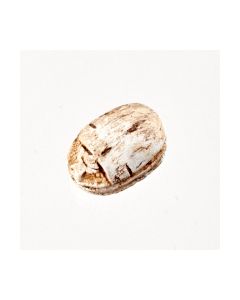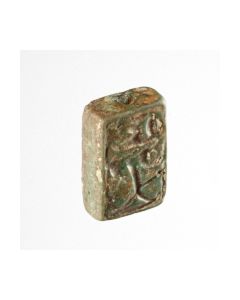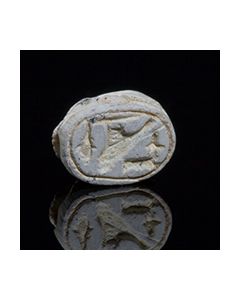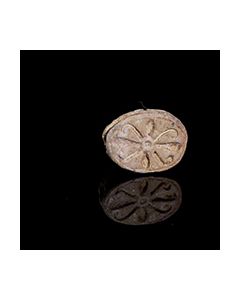Bronze Age - Egypt and North Africa - Sold antiquities
Archive of sold antiquities
All artefacts sold in our gallery are fully documented in our online archive and database. Being a specialist ancient art dealer, preserving also the more recent history of each and every piece sold in our shop is at our heart. That is particularly useful for artefacts that changed owners in the meantime. Information that may have been lost in the process can be easily restored from our archives. Please do not hesitate to contact us if you need further information about ancient items that have been sold in our gallery. We can help you with reconstructing the history of ownership for those items. All information about our customers will be kept confidential, of course.-
 Small scarab amulet with Isis hieroglyphs
Small scarab amulet with Isis hieroglyphsThe tiny amulet dates to the New Kingdom. It bears the glyphs for the goddess Isis. This scarab is described in the catalogue of Irène Gautier-Vodoz.
Price: on request Scarab with scarab motive
Scarab with scarab motiveThe stamp side shows a scarab with two uraeus snakes. This scarab is described in the catalogue of Irène Gautier-Vodoz.
Price: on request Scarab with lotus motive
Scarab with lotus motiveAncient Egyptian amulet seal with beautiful motive. Six lotus flowers are forming volutes. This scarab is described in the catalogue of Irène Gautier-Vodoz.
Price: on request Scarab with geometric motive
Scarab with geometric motiveThe lower side exhibits wrapped cords. A nice example of Egyptian art during the Second Intermediate Period. This scarab is described in the catalogue of Irène Gautier-Vodoz.
Price: on request Egyptian faience ring showing Bes and Taweret
Egyptian faience ring showing Bes and TaweretThe finger ring with its scene on the plate must have served a protective function for an expectant mother. New Kingdom, approx. 1550 to 1070 BC.
Price: on request Egyptian scarab with papyrus plants
Egyptian scarab with papyrus plantsScarab amulet made of bright, almost white steatite. 13th to 15th dynasty. This scarab is described in the catalogue of Irène Gautier-Vodoz.
Price: on request Scarab with the Red Crown of Lower Egypt
Scarab with the Red Crown of Lower EgyptThe scene can be seen as worship of the Deshret, the symbol of the kings of Lower Egypt during Hyksos times. An interesting piece of evidence of the Hyksos rule over Egypt.
Price: on request Scarab with sphinx
Scarab with sphinxThe stamp depicts a sphinx with pharaoh headcloth walking towards the Ankh symbol of life. The amulet should exert a protective function on the one carrying or owning it.
Price: on request Scarab with hieroglyphs arranged in a pattern
Scarab with hieroglyphs arranged in a patternThe lower side is skillfully decorated with hieroglyphs forming a geometric pattern. This scarab is described in the catalogue of Irène Gautier-Vodoz.
Price: on request Scarab from the Second Intermediate Period
Scarab from the Second Intermediate PeriodThe lower side shows a scarab, flanked by two uraeus snakes. 13th to 15th dynasty of ancient Egpyt. This scarab is described in the catalogue of Irène Gautier-Vodoz.
Price: on request Scarab with falcon headed god
Scarab with falcon headed godInteresting scarab amulet from the Second Intermediate Period. The seal shows a falcon headed creature facing an Egyptian cobra. This scarab can be found in the catalogue of Irène Gautier-Vodoz.
Price: on request Scarab with sphinx
Scarab with sphinxThe stamp depicts a human headed sphinx walking towards the Ankh symbol of life. The amulet should exert a protective function on the one carrying or owning it.
Price: on request Scarab with cartouche of Thutmose III.
Scarab with cartouche of Thutmose III.Amulet from the New Kingdom for one of the most popular rulers in ancient Egyptian history. This scarab is described in the catalogue of Irène Gautier-Vodoz.
Price: on request Scarab with two cartouches of Thutmose III.
Scarab with two cartouches of Thutmose III.Interesting amulet from the New Kingdom or a later period made in archaic style. This scarab is described in the catalogue of Irène Gautier-Vodoz.
Price: on request Cowroid with magical anra formula
Cowroid with magical anra formulaThe bottom side hieroglyphs of the anra type are to be interpreted as magical formula. The amulet dates to the Second Intermediate Period of ancient Egpyt.
Price: on request Scarab with breath of life
Scarab with breath of lifeThe Ankh on the bottom side of this ancient egyptian scarab symbolized life or afterlife. The symbol is framed by volutes.
Price: on request Skarabäus mit Kartusche des Chaneferre
Skarabäus mit Kartusche des ChaneferreSkarabäus mit Namens-Kartusche des Königs Chaneferre (Sobekhotep IV.). 13. Dynastie des Alten Ägyptens, ca. 1700-1680 v. Chr.
Price: on request Ägyptisches Plättchen mit Kartusche des Sethos I.
Ägyptisches Plättchen mit Kartusche des Sethos I.Doppelseitige Platte aus grüner Fayence aus dem Neuen Reich, ramessidisch, um 1290 v. Chr. Sphinx und Kartusche (Men-Maat-Re) und Namens-Kartusche mit dem Eigennamen Meri-en-Ptah.
Price: on request Ägyptisches Skarabäus Siegel
Ägyptisches Skarabäus Siegel18. bis 26. Dynastie, 13mm lang. Hieroglyphische Abbildung von Ibisvogel und Rascheibe.
Price: on request Ägyptisches Skarabäus Siegel
Ägyptisches Skarabäus Siegel12. Dynastie, 13mm lang. Kleine Beschädigung an Unterseite.
Price: on request Ushebti des Ptahhotep
Ushebti des PtahhotepÄgyptische Statuette in musealer Erhaltung. 400 bis 332 v.Chr., Spätzeit, 28. bis 30. Dynastie. 10cm hoch. Mit Hieroglyphentext: Der erleuchtete Osiris, Herr der Kraft, Gottes Diener, Ptahhotep, ...
Price: on request Ägyptischer Skarabäus aus blauer Fayence
Ägyptischer Skarabäus aus blauer FayenceCa 1000 v.Chr., 21. Dynastie, Dritte Zwischenzeit. Der Stempel zeigt ein Muster aus 10 Kreisen, Ober- und Unterseite vollständig und museal erhalten.
Price: on request Ägyptischer Skarabäus
Ägyptischer SkarabäusSkarabäus Siegel aus Steatit. Vorzüglicher Zustand. Ober- und Unterseite vollständig und museal erhalten, Stempel sehr tief, nicht abgenutzt und noch einwandfrei lesbar.
Price: on request Ägyptischer Skarabäus aus der Hyksos-Zeit
Ägyptischer Skarabäus aus der Hyksos-ZeitVorzüglich erhalten, exzellenter Stempel, ca. 1648 1540 v.Chr., 13. - 17. Dynastie, Zeit der Hyksos-Herrschaft.
Price: on request Ägyptischer Skarabäus aus blau-grüner Fayence
Ägyptischer Skarabäus aus blau-grüner FayenceVorzüglich erhalten, leuchtende, intensive Farben. 664 - 332 v. Chr., Spätzeit.
Price: on request Ägyptischer Skarabäus
Ägyptischer SkarabäusSehr schön gearbeiteter Körper, ca 1000 v.Chr., 21. Dynastie, Dritte Zwischenzeit. Der Stempel ist in 2 Register geteilt. Das obere Register zeigt 3 Vasen, das untere ist teilweise beschädigt.
Price: on request Ägyptischer Skarabäus für Pedubast
Ägyptischer Skarabäus für PedubastSeltenes persönliches Skarabäussiegel mit Namen, in Transkription Pedubast. 23. bis 26. Dynastie. Übergang von der 3. Zwischenzeit zur Spätzeit. Steatit, 11mm lang.
Price: on request Ägyptischer Spielstab aus Bein
Ägyptischer Spielstab aus BeinAlter Fund aus Abydos des Egyptian Exploration Funds (heute EES).
Price: on request Ägyptischer Spielwürfel aus Bein
Ägyptischer Spielwürfel aus BeinAlter Fund aus Abydos des Egyptian Exploration Funds (heute EES).
Price: on request Ushabti des Nes-ta-hi
Ushabti des Nes-ta-hiÄgyptische Statuette, rund 80mm hoch, 22. Dynastie. Ausgeprägten Gesichtszüge, schöne blau-grüne Fayence. Hieroglyphen in etwa Osiris, Nes-ta-hi, maa-kheru.
Price: on request Gemischte Perlen und Amulette, Altes Ägypten
Gemischte Perlen und Amulette, Altes ÄgyptenAltes Reich bis Neues Reich und bis in die Spätzeit/ ptolemäische Epoche. Material ist meist Fayence, Stein oder Glas. Durchmesser 1 bis 20mm. Preis pro Stück.
Price: on request Ushabti des Nes-ta-hi
Ushabti des Nes-ta-hiÄgyptische Statuette, rund 80mm hoch, 22. Dynastie. Ausgeprägten Gesichtszüge, schöne blau-grüne Fayence. Hieroglyphen in etwa Osiris, Nes-ta-hi, maa-kheru.
Price: on request Lot aus 20 gemischten Perlen von der Levante
Lot aus 20 gemischten Perlen von der LevanteDiverse Materialien und Maße, ca. 1800 v.Chr. bis 640 n.Chr, ägyptisch/kanaanitische, hellenistische, römische und byzantinische Perlen.
Price: on request Ushabti des Nes-ta-hi
Ushabti des Nes-ta-hiÄgyptische Statuette, rund 80mm hoch, 22. Dynastie. Ausgeprägte Gesichtszüge, schöne blau-grüne Fayence. Hieroglyphen in etwa Osiris, Nes-ta-hi, maa-kheru.
Price: on request Ägyptischer Skarabäus aus blau-grüner Fayence
Ägyptischer Skarabäus aus blau-grüner FayenceGute Erhaltung, sehr schöne Farbgebung und Patina. Stempel lesbar, 664 - 332 v. Chr., Spätzeit.
Price: on request Perle mit demotischem Stempel und weitere Perlen von der Levante
Perle mit demotischem Stempel und weitere Perlen von der LevanteDiverse Materialien und Maße, ca. 1800 v.Chr. bis 640 n.Chr
Price: on request

